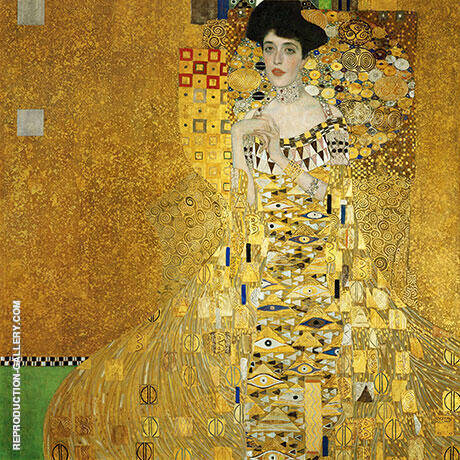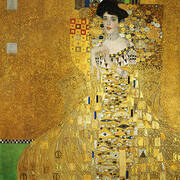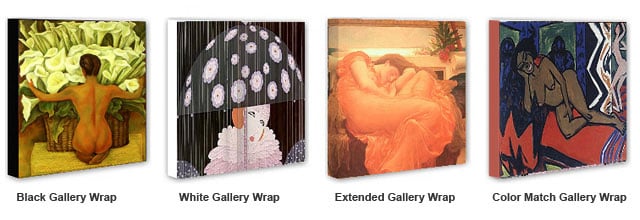Portrait of Adele Bloch-Bauer I 1907 By Gustav Klimt
Portrait of Adele Bloch-Bauer by Gustav Klimt
Portrait of Adele Bloch-Bauer, also known as The Lady in Gold or Woman in Gold, is one of the most famous Gustav Klimt artworks and one of our Popular Paintings. Gustav Klimt was the founder of the Secessionist Art Movement. Original members of the Secessionists are Carl Moll and Koloman Moser.
Why did Gustav Klimt paint the Portrait of Adele Bloch-Bauer?
Adele Bloch-Bauer was a wealthy Jewish socialite born in Vienna in 1881. Klimt painted two portraits of her in addition to his gold leaf painting Adele Bloch-Bauer I, The second painting Adele Bloch-Bauer II was completed in 1912. She died of Meningitis at the age of 42. Ferdinand Bloch-Bauer, a Jewish Banker and sugar producer, commissioned Gustav Klimt's portrait painting. It was painted between 1903 and 1907 to honor Ferdinand's wife. The Bloch-Bauer family were patrons of the artist, owning several Gustav Klimt paintings.
Amongst Gustav Klimt's art, this painting represents the culmination of his Golden Phase. Klimt made over a hundred preparatory sketches for his oil painting, taking inspiration from Byzantine mosaics and Religious art. It is one of Gustav Klimt's famous gold leaf paintings, which uses an elaborate process of layering gold and silver leaf. Klimt's characteristic ornamental motifs were later added in relief.
Despite the lengthy preparations, critics reacted with barely veiled contempt when Gustav Klimt's painting was first exhibited at the Mannheim International Art Show in 1907. Bizarre, grotesque, and vulgar were just some of the words describing the piece. Critics primarily disapproved of the sitter’s loss of individuality amidst the sea of gold. One commentator, Eduard Potzl, complained it was “more brass than Bloch.”
Who Owns Portrait of Adele Bloch-Bauer?
Bloch-Bauer died in 1925, stipulating that her portraits should be donated to the Österreichische Galerie Belvedere, Vienna. However, they were technically owned by her husband. Like many other Gustav Klimt's famous paintings, the portrait does not have a straightforward history. It was stolen in 1941 by the Nazis, and the Bloch-Bauer painting became a possession of the German state. Ferdinand himself has already successfully fled Vienna, making his way to Switzerland.
A tax evasion charge was made against Ferdinand Bloch-Bauer, and the sale of his art collection was used to offset the claim. In a strange twist of fate, the German lawyers re-donated the portrait to the Österreichische Galerie Belvedere. On his death in 1945, Ferdinand bequeathed his entire estate to his nephews and nieces. They subsequently launched legal challenges against the gallery, attempting to reclaim artworks stolen during the Second World War. After a lengthy, seven-year legal battle, the Gallery returned some 5 Klimt paintings to the Bloch-Bauer family. They sold the Portrait of Adele Bloch-Bauer in 2006 when it was purchased for $135 million by the legendary art collector Ronald Lauder and returned to the United States.
Klimt's famous portrait painting now hangs in the Neue Galerie, a New York Museum of early 20th century German and Austrian Art. The museum collection includes paintings by Egon Schiele, Ernst Ludwig Kirchner, and the color art of August Macke.
The five paintings by Gustav Klimt which were proved to be stolen and returned to the Bloche-Bauer family are:
- Portrait of Adele Bloch-Bauer I
- Portrait of Adele Bloch-Bauer II
- Beechwood 1903
- Apple Trees 1911
- Unterach on Lake Atter 1916
What was the Vienna Secessionist Movement?
Gustav Klimt was one of the founding members and President of the Vienna Secessionist art movement, formed in 1897. The Secessionists represented artists hoping to break free from the classical conservatism and stifling rules of the Viennese Künstlerhaus. This prestigious group of artists resigned en masse from the Association of Austrian Artists. As a pioneering and sometimes scandalous avant-garde artist, Gustav Klimt railed against the hypocritical boundaries prevalent in Viennese Society. He aimed to elevate applied arts to traditional fine art status.
Many Gustav Klimt oil paintings consequently embraced the latest Art Nouveau style, mixed with his characteristic geometric minimalism. It was partly due to Klimt's reputation as a painter of decadence, opulence, and beauty that he became the portrait painter of the day for wealthy bourgeois families. In the early 1900s, rising industrialism created a new class of wealthy business owners open to innovative artistic approaches.
The Kiss by Gustav Klimt is undoubtedly the most iconic and famous painting. However, both The Kiss painting and Portrait of Adele Bloch Bauer are acknowledged as two of the most beautiful paintings by Gustav Klimt. The Portrait of Adele-Bloch Bauer perfectly represents the confluence of these historical factors and is one of the most beautiful Portrait Paintings of all time.
Fine Art Reproductions of Popular Paintings by Gustav Klimt.
We have been creating fine art reproductions since 1996 and are the original reproduction oil painting company. We currently have over 30,000 famous paintings in our online art catalog, all covered by our 100% Money Back Guarantee. If you cannot find your favorite oil on canvas painting, you can Request a Painting. Custom Paintings comprise around a third of our work.
Fine art reproductions of Gustav Klimt artworks are firm favorites with our customers. We use real gold paint and gold leaf in our golf wall art. Oil painting reproductions by famous artists are a stunning centerpiece in any room.
We offer a 100% money back guarantee or replacement service. If for any reason you are dissatisfied with your painting please contact us within 7 days of receipt, advising the reason you are unhappy and we will provide you with all the information you need for its return or replacement.
We ship free to anywhere in the world via FedEx or DHL expedited service with online tracking.
Your painting will be shipped rolled in strong plastic tubing, ready for stretching and/or framing locally. This is the conventional method of transporting hand-painted oil on canvas. Learn more about how your painting is shipped.
We are able to offer a framing service intercontinental U.S. Please contact us if you would like a quotation. Alternatively, should you prefer, we can recommend a framer in your area.
Notes About Your Painting
Please note that replica oil paintings are finished with an additional 10cm (4") of extra canvas on all sides, allowing ample surplus canvas for stretching and framing.
Recently Viewed:
Cannot Find What You Are Looking For?
Reproduction Gallery Information
Customer Service
(Send Us A Message)
Tel: (503) 937 2010
Fax: (503) 937 2011







